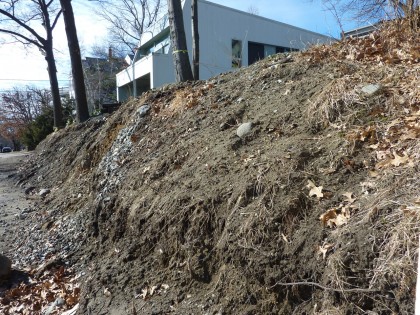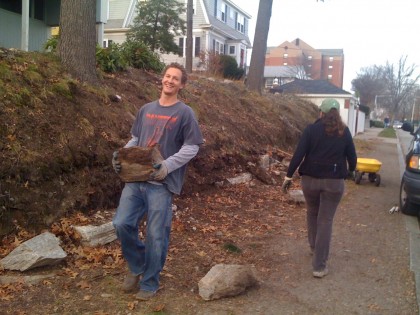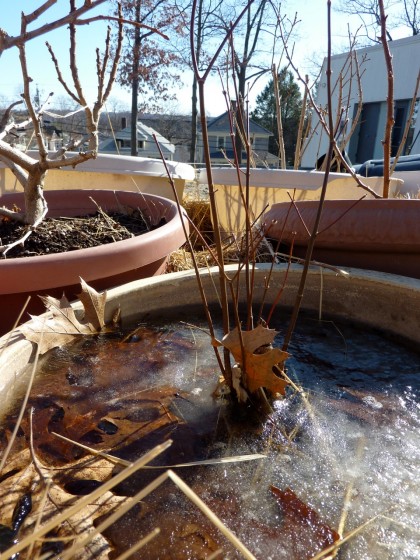Chomping at the bit to garden. But there’s really only one spot on the property that’s ready to go: the steep slope at the bottom of the hill. I call it the erosion zone. Interested in the plan at all? Take my hand.
First, lets look at the site we have to work with…
Desolate. 95′ long. At least 8′ up between street-level and top of the slope. It’ll take a shizzle-load of plants to fill it. This is what it looks like after Luke and Shiva…
tore apart that partial stone wall, then weeded and yanked out the cantankerous shreds of juniper right around Thanksgiving. Thanks, mates!
That leaves a blank slate. Or blank slope, if you prefer. And a few issues that affect plant choice. Maybe you have some challenges like these, too?
- Eastern-facing slope under oaks — gets full morning sun and full afternoon shade. This means I need plants that can thrive in an either/or situation. I’d also like some color to brighten the shade. Luckily it’s steep enough that the acidic oak leaves slide down and blow away. I don’t see baby oaks anywhere, so acorns must roll down.
- Steep embankment — first, we need erosion control. Second, weed control, because this slope is practically impossible to weed. No chemicals, not ever. I want a weed-control mat that smothers weeds, allows water to soak into the soil and breaks down naturally — more on sustainable options another time. I need plants to fill in quickly to discourage weed growth — fast climbers, spreaders and creepers.
- Far from water — except to get the plants established, this area will not be watered. This means I need fairly hardy and mostly dry-loving or drought-tolerant plants.
- Soil is probably meh — not that great, not that bad. We should get our soil test back in the next week or two to know for sure. For this zone, I’m betting on plants that don’t care. Although we’re going to bring in a truckload of loam to fill in some of the more eroded spots, soil will only be specifically amended in the planting holes.
But wait. To add complication, I’m bringing my own issues to the party. Why not? It’s my party, right?
- No invasive, crap or boring plants — invasive, bad. So no vinca or barberry allowed here. And boring? I promise I can do better than the standard pachysandra I see everywhere. Color and texture are important to me, even though we’ll never be able to see this zone from the house. We have a steady stream of walkers to Providence College down the block… let’s do something nice for them.
- Must work in some native species — this helps take care of many issues above. I love exotics too, but it’s important to promote biodiversity and protect our natural heritage by relying on some North American natives. Helps conserve water and is better for the ecosystem. Besides, there are tons to choose from. More on this in another post.
- Must be friendly to wildlife — in addition to no chemicals, I want flowers for butterflies and bees, and fruit for birds. Creating habitat in the city is definitely a must.
Based on that, I did some research and came up with an initial list of plants that would work in our erosion zone. Then I enlisted help. With so much time spent working, there just aren’t enough hours in the day for me to get this done on schedule. Shiva has tons of experience in garden design, procurement and snapping a bullwhip, so she’s my go-to gal on making the hillside happen for spring. We wrangled a little on idears… I talked her into some of mine, she talked me into some of hers. It all worked out to be something that will look awesome.
Gardeners, take note: not your typical plant choices coming up in part two.
Meawhile, the rest of my plants sit patiently in pots amidst the hay bales… waiting… waiting…
Tags: garden, green, landscaping, sustainable


